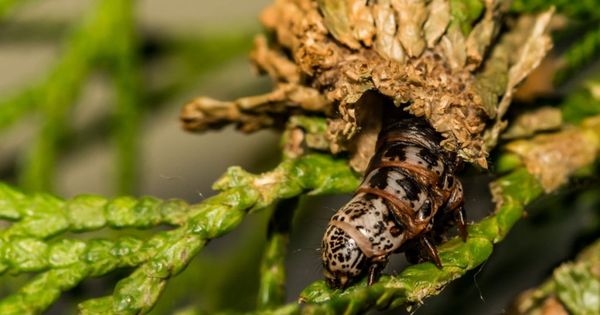
If you’ve ever experienced an Evergreen Bagworm infestation, you know how devastating it can be for your trees. These small creatures can strip trees of their pine needles, eventually leading to their demise. It’s a sad end for the beautiful evergreen trees we all cherish. But fear not, because there are ways to save your trees if you take action.
Meet the Silent Killer: The Evergreen Bagworm

Contrary to its name, the Evergreen Bagworm is not a worm but a moth in its larval stage. These deceptive creatures can wreak havoc on both evergreen and deciduous trees, causing extensive damage and even death if left uncontrolled. They construct distinctive bags or cases made from plant debris, which serve as their shelter and camouflage. These bags hang from tree branches, giving them the appearance of small bags.
Understanding the Life Cycle of the Evergreen Bagworm

To effectively manage the Evergreen Bagworm, it’s crucial to understand its life cycle. The reproductive cycle begins when the female adult lays her eggs inside her bag, which she leaves hanging on the tree after her passing. These eggs remain dormant throughout the winter and hatch in late spring or early summer, giving birth to tiny larvae. The larvae then leave the bag and search for a suitable host tree, where they start building their bags using silk from their bodies. As the larvae grow, their bags become larger and more noticeable.
The larvae go through several molts, shedding their skin to accommodate their increasing size. Each instar (or stage) of growth requires a new bag. By late summer or early fall, the larvae reach their final instar and prepare to pupate. Inside their protective cases, they transform into adult moths. The males, which are darker, smaller, and have clearer wings, fly off in search of females, while the larger, wingless female moths stay close to the original tree.
The Destructive Nature of the Evergreen Bagworm
At first glance, Evergreen Bagworms may seem harmless, but if left uncontrolled, they can seriously harm trees. They are voracious eaters and feast on the foliage of various tree species. The defoliation caused by their feeding activities makes it difficult for trees to produce the nutrients they need to grow and survive. This weakens the trees and makes them more susceptible to other illnesses, pests, and environmental stressors. In severe cases, Evergreen Bagworms can cause tree decline and even death.
Managing Evergreen Bagworm Infestations
To protect the health of your trees and minimize the damage caused by Evergreen Bagworm infestations, consider the following strategies:
1. Manual Removal
For small infestations, manually removing the bagworms by hand can be effective. Carefully inspect the tree branches, identifying and gently removing the bags. Be sure not to drop them on the ground, as they can cause reinfestation.
2. Pruning and Destruction
If the infestation is more widespread, prune the affected branches and destroy them appropriately. Bagworms may also construct bags on nearby structures, such as fences, which should be inspected and removed if necessary.
3. Biological Control
Encourage natural predators like birds and parasitic wasps, as they feed on bagworms and can significantly reduce their population. Creating a diverse garden ecosystem supports these natural predators.
4. Chemical Control
In severe infestation cases or when other methods prove ineffective, chemical control may be necessary. Use insecticides specifically formulated for bagworm control, following the manufacturer’s instructions. However, use chemicals responsibly and only as a last resort to minimize environmental impact.
Maintaining Healthy Trees
Prevention is always better than treatment when it comes to Evergreen Bagworms. Follow these practices to reduce the chances of infestation and improve your trees’ overall health:
1. Regular Inspection
Regularly inspect your trees, especially during spring and early summer, to detect signs of bagworm infestation. Early detection makes management easier and prevents widespread damage.
2. Good Tree Maintenance
Properly maintain your trees by pruning dead or damaged branches, keeping them well-watered and fertilized. Healthy trees are more resistant to infestation and can recover more effectively.
3. Remove Bagworm Bags
If you find any bagworm bags during your inspections, promptly remove and destroy them. This proactive measure prevents the spread of these pests to other trees.
4. Avoid Overcrowding
Maintain proper spacing between trees to enhance air circulation and reduce the risk of infestation. Avoid overcrowding, which can make it easier for bagworms to spread.
5. Monitor Surrounding Vegetation
Keep an eye on neighboring trees and plants, as bagworms can migrate from one host to another. Take necessary precautions if you notice signs of infestation nearby.
The Bottom Line
Despite their small size, Evergreen Bagworms have the ability to silently kill trees. By understanding their life cycle, recognizing their destructiveness, and taking proactive management measures, you can protect your trees and maintain the beauty and vitality of your landscape. Regular inspections, preventative measures, and maintaining healthy trees will go a long way in preventing infestations.





